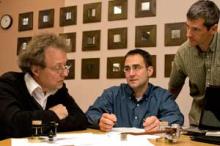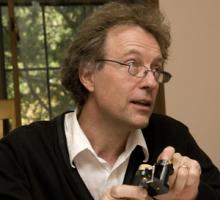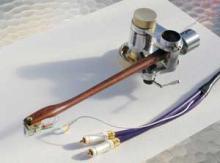Composition professor Joel-Francois Durand spent his summer working at the UW campus, but was rarely seen in the Music Building. Instead, the associate director of the School of Music logged more than 800 hours in the Department of Mechanical Engineering's machine shop, immersed in what he calls his "unipivot tone arm project."
"I began this project in January of this year with no particular ambition other than to see what would happen," he says of his quest to create a piece of high-fidelity stereo equipment that would combine crystalline sound and beautiful aesthetics. Nine months and more than 30 design iterations later, Durand finds himself in a somewhat surprising position, that of inventor and entrepreneur, with a patent pending, a recently formed business, collaborative relationships with new connections in the Business School, the School of Law, the Departments of Mechanical Engineering and Material Science and Engineering, and the School of Art, and a first-hand understanding of how the UW's Office of Technology Transfer plays a pivotal role in bringing UW faculty research innovations to the marketplace.
Durand's design, a tonearm dubbed the Talea, is unquestionably sleek in appearance and delivers a tone that was called "nothing short of amazing" at its first public showing at the 2009 Rocky Mountain Audio Fest in Denver in early October. But what sort of market could exist for an invention that serves what some might consider an obsolete audio format?
The Talea is not intended to have mainstream appeal; it is intended to serve audiophiles who extol the virtues of analog sound. For those listeners the record player is still very much a viable piece of gear, delivering far more natural sound than the mp3 and other digital formats. Setting the Talea apart from other high-end audio tone arms is an innovation that enables the listener to adjust the angle of the needle on the fly, or while it is actually in the groove of a spinning record. This feature enables minute adjustments to be made to the tonal balance while a record is playing, so that listeners may judge with their own ears when the sound is perfectly "in the groove."
Approaching the Office of Tech Transfer with his design, Durand found a receptive team of collaborators who have since guided him through the process of applying for a patent on his design and licensing it for commercial use. Durand will share a portion of any royalties he receives with Tech Transfer, which reinvests its revenues in the UW research enterprise by offering funding opportunities through the University's Royalty Research Fund. Tech Transfer has also connected Durand with legal help from the School of Law and business consulting assistance from the Business School to help him navigate all the complexities of starting a new commercial venture.
"I'm hoping to be ready to sell the first exemplars by the end of 2009, if all goes well," Durand says. "I never thought this would become a commercial venture, but there we are. The journey continues."
More information about the Talea is available here.


